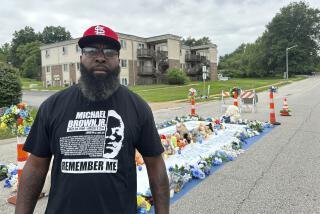Editorial: The lessons of Baltimore, and Ferguson, and too many places
Half a century ago, in the weeks between the bloody beating of civil rights marchers by Alabama state troopers on Selma’s Edmund Pettus Bridge and the six days of looting, arson and death in Watts, it would have seemed unthinkable that people then living would see an African American as president of the United States, or as a mayor or police chief in a city like Baltimore. The nation has come far since 1965.
But it is as unthinkable today — or rather, it ought to be — that arrests continue to result in so many deaths and that the suspects-turned-victims still are so disproportionately African American.
The in-custody death of Freddie Gray in Baltimore this month and the protests and riots that followed his funeral are reminders not just of unfinished business but of the complex texture of the issues raised over the last year in places like Ferguson, Mo.; Staten Island, N.Y.; South Carolina and Los Angeles, to name only a few.
Race remains central, but Baltimore, with its black political leadership and its police force stocked with black officers, is no Ferguson, which to outsiders appears more of a throwback to the segregated Selma and Watts, where African Americans of all social classes and all economic tiers were united by oppressive laws and restricted lives. Many commentators argue that the violence in Baltimore is not just about race, but is a result of economic disparity and successive generations of youths stuck in failed schools and neglected neighborhoods who place little hope in the future despite changes in law.
That may well be, and it’s a subject that requires continued attention and action. But that discussion cannot be allowed to sideline much-delayed progress in the basics of police patrol and arrest.
No city as small as Ferguson or as large as Baltimore or Los Angeles has any legitimate reason not to be currently revisiting its training and protocols for arrests, for encounters with mentally ill suspects, for medical attention for arrestees. There is no excuse, with today’s tools and technology, not to make data — including race — on arrests and in-custody deaths and injuries, as well as discipline meted out to abusive officers, publicly available and subject to scrutiny.
Police work in the 21st century requires more than it did half a century ago. Sending officers into the field without proper vetting and up-to-date training, and without governments working to communicate with and economically empower their communities, is as irresponsible and immoral as sending soldiers into battle unarmed.
Better arrest protocols and policies will not, by themselves, constitute justice. But they are an essential component of it, one that has been neglected too often and in too many places amid the progress and failure of the last 50 years.
Follow the Opinion section on Twitter @latimesopinion and Facebook
More to Read
A cure for the common opinion
Get thought-provoking perspectives with our weekly newsletter.
You may occasionally receive promotional content from the Los Angeles Times.










